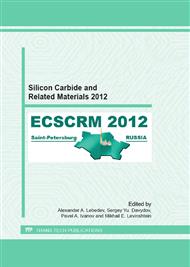p.1052
p.1056
p.1060
p.1065
p.1069
p.1073
p.1077
p.1081
p.1085
Vertical Channel Silicon Carbide JFETs Based Operational Amplifiers
Abstract:
Superior performance of the Silicon Carbide (SiC) semiconductor in high temperature and harsh environment is widely known. However, utilizing the Vertical Channel 4H–SiC JFET (SiC VJFET) for analog circuit design exhibits significant design challenges, even at room temperature. The fundamental challenges are low intrinsic gain, the limitation of the Gate to Source Voltage Range (GSVR), and restrictions on utilizing Channel Length (CL) as a design parameter due to fabrication complexity. These challenges must be successfully overcome at room temperature, before moving forward with high temperature design. After addressing these issues, two operational amplifiers (opamps) with two distinct design topologies are designed and fabricated. The first design (opamp-1) emphasizes on the gain and Common Mode Rejection Ratio (CMRR) performances [1]. The second design (opamp-2) presents a novel opamp [2] with universal applications where the reliability and unity gain frequency performances are also improved. In this paper, the performance parameters of these two opamps along with their design topologies are reported and compared.
Info:
Periodical:
Pages:
1069-1072
Citation:
Online since:
January 2013
Authors:
Price:
Сopyright:
© 2013 Trans Tech Publications Ltd. All Rights Reserved
Share:
Citation:


